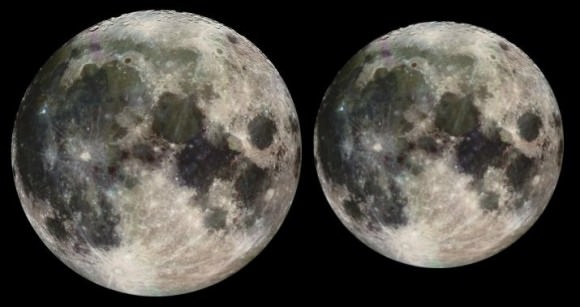
Moon at Perigee and Apogee. Credit NASA
Over the course of the year, observers on Earth can view a bit less and a bit more than half of the lunar surface. Additionally, the Moon appears smaller in the sky during some months compared to other times of the year.
Due to the processes at work, tonight’s full Moon is an opposite of the “Supermoon” that made headlines earlier this year.
What causes our Moon to change apparent size throughout the year, and how do we notice this phenomenon?
While it would be difficult to judge the apparent size of the full Moon each month with our eyes, the phenomenon of Lunar librations is readily apparent in the animation below.
There are three forces at work that help produce the “dancing” effect as shown in the video above.
There are three types of lunar libration:
First, the Moon doesn’t orbit Earth in a perfectly circular orbit. An eccentric orbit will cause our Moon to lead and lag in its orbital position while its rotational speed stays the same. This causes a libration in longitude.
Secondly, the Moon’s rotational axis is slightly inclined to its orbital plane, with respect to Earth. The Moon’s orbit is also inclined with respect to the ecliptic, allowing the Moon to be illuminated from above and sometimes from below. The illumination from above and below allows some of the lunar surface beyond the poles to be visible from Earth.
Last but not least, there is a small daily oscillation due to Earth’s rotation. This oscillation changes the perspective at which an observer views the Moon. Imagine a straight line connecting the center of Earth with the center of the Moon. Over time an observer would be on one side of this imaginary line and then the other, which would allow the observer to look first around one side of the Moon and then around the other. This is because an observer on Earth is on the surface and not at the center of Earth.
A slight bit of Lunar trivia: Lunar librations helped notable British astronomer Patrick Moore investigate the edge regions where librations provided extra coverage. Moore’s investigations lead him to discover a large circular feature, which he named “Mare Oriental”. Once studies of the Lunar farside were performed from space, it was discovered that Mare Oriental was a lava filled impact crater.

No comments:
Post a Comment